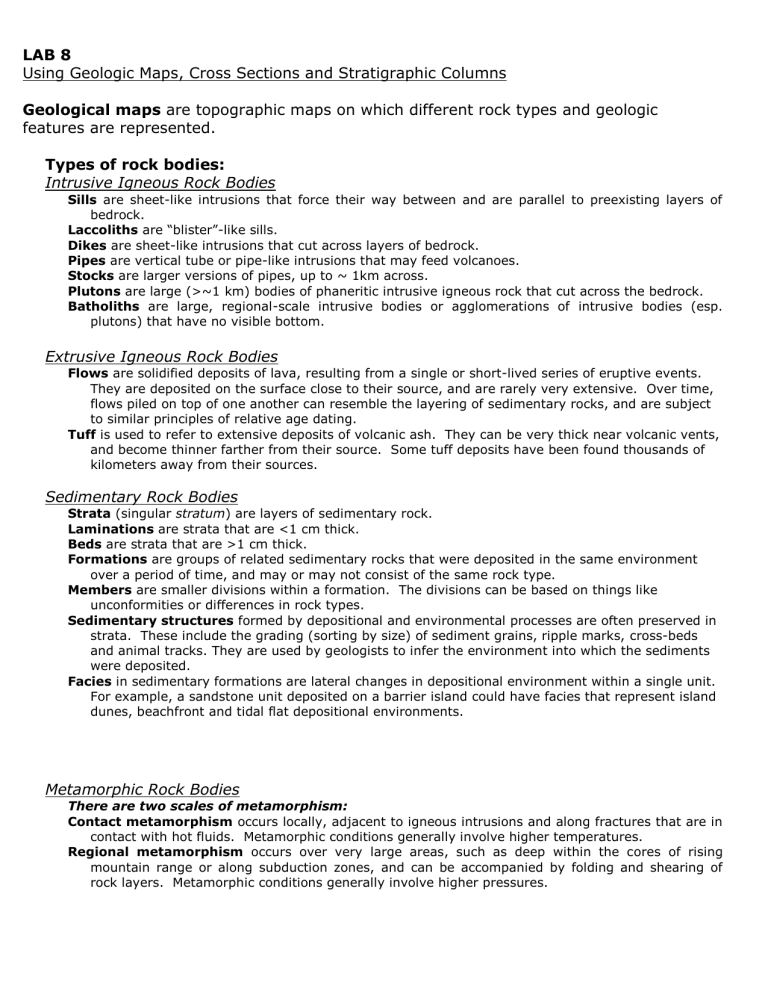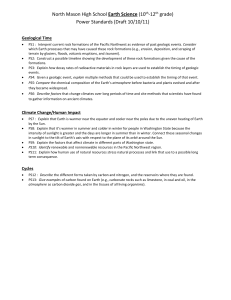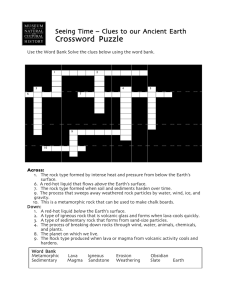Geological maps (see fig

LAB 8
Using Geologic Maps, Cross Sections and Stratigraphic Columns
Geological maps are topographic maps on which different rock types and geologic features are represented.
Types of rock bodies:
Intrusive Igneous Rock Bodies
Sills are sheet-like intrusions that force their way between and are parallel to preexisting layers of bedrock.
Laccoliths are “blister”-like sills.
Dikes are sheet-like intrusions that cut across layers of bedrock.
Pipes are vertical tube or pipe-like intrusions that may feed volcanoes.
Stocks are larger versions of pipes, up to ~ 1km across.
Plutons are large (>~1 km) bodies of phaneritic intrusive igneous rock that cut across the bedrock.
Batholiths are large, regional-scale intrusive bodies or agglomerations of intrusive bodies (esp. plutons) that have no visible bottom.
Extrusive Igneous Rock Bodies
Flows are solidified deposits of lava, resulting from a single or short-lived series of eruptive events.
They are deposited on the surface close to their source, and are rarely very extensive. Over time, flows piled on top of one another can resemble the layering of sedimentary rocks, and are subject to similar principles of relative age dating.
Tuff is used to refer to extensive deposits of volcanic ash. They can be very thick near volcanic vents, and become thinner farther from their source. Some tuff deposits have been found thousands of kilometers away from their sources.
Sedimentary Rock Bodies
Strata (singular stratum ) are layers of sedimentary rock.
Laminations are strata that are <1 cm thick.
Beds are strata that are >1 cm thick.
Formations are groups of related sedimentary rocks that were deposited in the same environment over a period of time, and may or may not consist of the same rock type.
Members are smaller divisions within a formation. The divisions can be based on things like unconformities or differences in rock types.
Sedimentary structures formed by depositional and environmental processes are often preserved in strata. These include the grading (sorting by size) of sediment grains, ripple marks, cross-beds and animal tracks. They are used by geologists to infer the environment into which the sediments were deposited.
Facies in sedimentary formations are lateral changes in depositional environment within a single unit.
For example, a sandstone unit deposited on a barrier island could have facies that represent island dunes, beachfront and tidal flat depositional environments.
Metamorphic Rock Bodies
There are two scales of metamorphism:
Contact metamorphism occurs locally, adjacent to igneous intrusions and along fractures that are in contact with hot fluids. Metamorphic conditions generally involve higher temperatures.
Regional metamorphism occurs over very large areas, such as deep within the cores of rising mountain range or along subduction zones, and can be accompanied by folding and shearing of rock layers. Metamorphic conditions generally involve higher pressures.
Metamorphic grade refers to the temperature and pressure under which a rock was metamorphosed, considered low grade or high grade. Since metamorphic minerals in a rock form under specific conditions, they are used to identify the temperature and pressure of the metamorphic conditions.
Metamorphic facies are zones of metamorphic rock wherein the metamorphic mineralogy suggests different pressure and temperature conditions than adjacent zones. For instance, you might expect a high temperature metamorphic facies in the country rock next to an intruding pluton, but a lower temperature facies would exist farther away from the pluton.
Contacts are the boundaries between different rock types or formations.
Contacts are curviplanar features in 3-D that are represented as lines on a map where they intersect the topographic surface.
Types of contacts
Depositional: a contact on which a rock formation has been deposited through water, eruptive or airborne processes on top of another formation.
Unconformity: a depositional contact across which a span of time is left unrepresented in the rock record.
Intrusive: the contact between an intrusive igneous rock and the rock it intruded (the “country rock”).
Fault: the contact between rock units is a fault, a fracture along which movement has occurred.
Legend is included with the map and defines what the different map colors, patterns and symbols represent. Only symbols representing features seen in the map area will be shown on the map legend.
With the geologic map and a legend, you have all the information you need to construct cross sections, general stratigraphic columns and gain a basic understanding of the geology of an area.
350
300
250
200
150
100
50
0
Cross Sections are vertical “slices” into the earth that are used to interpret the geology at depth. The geological data (contacts, dips of formations, etc.) are projected from the surface into the cross section to predict what might be down there. They are often included with geological maps.
Stratigraphic Columns are vertical representations of the thicknesses of the various formations in a given area. Once a vertical scale is chosen, each formation or unit is represented on the column at the thickness it crops out in the map area.
Scale in feet
The modified example above is a stratigraphic column representing formations exposed at Niagra Falls. Notice the resistance to weathering of the different units is shown by how far each protrudes to the right side. The name of each unit is given. Also notice the different symbols for the different rock types.
Here is a list of geological map symbols below. Note the special letter designations for ages. The exact symbols used may vary from map to map, but these are the general forms.
INTERPRETING GEOLOGIC MAPS
DO NOT WRITE ON, RIP OR OTHERWISE ABUSE THE MAPS!
Remember to use all information to answer the questions – maps, legends, cross sections and descriptions. All the information is there…
43
44
K n o tma i Fa u lt
42
45
43
Ye r Fault
Y
43
42
40
X
Tertiary
Puertocitos Diorites
Jurassic
Bullwinkle Basalt
Triassic
Scooby Sandstone
Permian
Kong Conglomerate
Silurian
Gastil Sandstone
Ordovician
Shoo Fly Shale
Geologic Map of the Eddie Bo Plains area
Compliled by J. Dana, G.K. Gilbert and R.L. Bowen
Cambrian
Lafitte Limestone
Faults
one kilometer
N
Geological map of the Eddie Bo Plains
(Remember, the plains are flat – there is no topographic relief)
1.
What is the general (average) direction of strike of the sedimentary beds?
2.
What type of contact is between the Gastil Sandstone and the Kong Conglomerate?
3.
The Yer Fault dips 20 northeast. What kind of fault is it? Use what you know about the ages of the rocks on either side of the fault.
4.
The Knotmai fault is vertical (90 dip). What kind of fault is it?
5.
How much offset has occurred on the Knotmai Fault?
6.
What are the ages of the Knotmai and Yer Faults? Noting the youngest rocks cut by each fault might help.
7.
Using the structural data given on the map and above, draw a geologic cross section along the line marked X-Y. Label, color or put a pattern in the formations (Use the cross section page provided).
8.
On the blank page provided, write out your interpretation of the geological history of the Eddie Bo Plains area. Include all episodes of deposition, erosion, intrusion, deformation, etc. in chronological order from oldest to youngest .
Geologic History of the Eddie Bo Plains Area
Map C: Coaldale, Nevada
1.
What is the scale of the map? How many feet does one inch on the map represent?
2.
What is the magnetic declination in the map area? What is the contour interval?
3.
Circle the name of the mountain range with the steepest topography: Pilot
Mountains, Cedar Mountain, Monte Cristo Range or Lone Mountain?
4.
What three Nevada counties have jurisdiction over the map area?
5.
What is the straight-line distance between Coaldale and Blair Junction?
6.
Give the azimuth directions for the following:
Rock Hill looking toward the town of Alpine
Mitchell Spring in the Pilot Mountains looking toward
BM 6246 (that’s a survey benchmark at 6246 feet)
7.
The Tertiary Period is divided into several Epochs. Name the Tertiary Epochs that are represented by formations in the map area.
8.
How many unconformities are exposed in the map area?
9.
What Period(s) are missing between the Diablo formation and the Palmetto formation?
10.
What Period(s) are missing between the Intrusive rocks and the Older lavas?
11.
What types of faults are exposed in the Pilot Mountains along the cross section A to A’? What are their names, ages, and what do they suggest was the type of stress the area was under at that time?
12.
Give the attitude of formations exposed in the following places:
Cambrian formation east of Alpine
Strike: Dip:
Excelsior formation north-northeast of Coaldale
Strike: Dip:
Older lavas west of Royston Valley
Strike: Dip:
13.
Name the types of geologic contacts for the following:
Between Intrusive and Cambrian east of Alpine:
Between Intrusive and Desert wash northeast of Alpine:
Between Excelsior formation and Palmetto formation north-northeast of Coaldale:
14.
The prospector Seldom Seen Slim has brought you two mineral samples from a site in the Pilot Mountains. Identify them.
Luster Mineral Color Streak Diagnostic
Properties
Mineral Name
What ore can Seldom Seen Slim expect to get out of this mine based on your mineral identifications?
15.
Identify the rock samples provided, and answer the questions with the map, legend and your rock data.
Sample Rock Type Texture Minerals and Other Features Rock Name
A
B
C
D
16.
From which member of the Dunlap Formation was Sample A above likely taken?
17.
From which unit of the Luning Formation was Sample B above likely taken?
18.
Which location was the most likely source for Sample C: Cambrian formations, the Columbia Salt Marsh or the Older Gravels north of Redlich? Why?
19.
Based on the rock type, environmental origin and legend descriptions, to which unit does Sample D belong?
What is the geographic location of the most likely outcrop source for Sample D?




